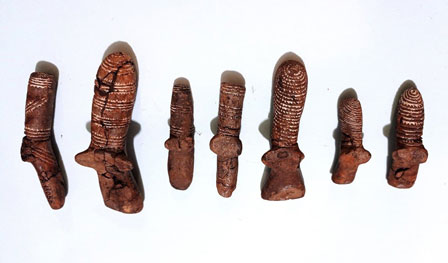Collection of the National Historical Museum named after D.I. Yavornytskyi was formed over several centuries. And museum objects entered our collection from the hands of prominent people. Even if we talk about individual collections of the museum collection, in particular, ceramics, then we have to mention the figures of Ukrainian historical science who are simply gigantic.
In the exposition of the ancient history of our museum, there is an exhibit that was found during the excavations conducted by Vikentiy Khvoika. The Trypil korchaga, found in the Kyiv region, was transferred in the 1930s as part of an inter-museum exchange. It gives us the opportunity to remember this extraordinary and legendary figure in Ukrainian historical science, and his contribution to public consciousness.
Another Trypil pot found in the territory of our region – near the village of Zhivotylivka, Novomoskovsk district, in the Maidan mound, excavated in 1934, is also present in the exposition. The fate of the person from whose hands this pot got into the museum collection, unfortunately, accurately reflects the tragic history of Ukraine in the 1930s. Trokhym Teslia, a brilliant scientist who was to become the pride of the national historical science, shared the fate of the Ukrainian intelligentsia, was arrested and, by order of the military prosecutor of the Kyiv Military District, shot. In order to hide the scale of the executions, the sentence was hidden, instead the family was informed of the sentence – 10 years without the right to correspond, and relatives for many years cherished hopes for Trochym’s return.
Of course, the lion’s share of the collection consists of exhibits that were found and given to the museum by Dnipro historians. The author of the exposition of the Hall of Ancient History is Lyudmila Krylova. She devoted more than 20 years to archeology and the museum and, of course, most of the ceramics that can be seen in the hall were found thanks to Lyudmila Petrivna. Among these items there are such unique ones as the Serezliiv statuette, a frankly cult item. The first researchers attributed such statuettes to the late Tripillia, and only Dmytro Telegin singled them out as an independent group. It is interesting that the Serezliiv figurine found by Lyudmila Krylova is significantly supplemented by the collection of figurines found by another outstanding archaeologist of our city – Volodymyr Romashka. Unfortunately, it is located in the funds, however, modern technologies will make it possible to demonstrate them to visitors.
Since Dmytro Telegin’s name has already been heard, there is an opportunity to show visitors an object that has entered the collection from the hands of this restless and dedicated scientist. This is the first item in the exhibition from the ceramic collection that actually meets the visitor – a Neolithic pot found in 1967 in the Solonyan district in the village of Mykilske-on-Dnieper, in a well-known Neolithic burial ground. Practical archeology, scientific developments, publishing activities, protection of monuments, pedagogical work, and, finally, a children’s circle – this is all about Telegin. The versatility and efficiency of the scientist is impressive.
Of course, it is impossible to ignore the archaeological activity of Dmytro Yavornytskyi. A large part of his efforts was dedicated to archeology and the exposition has an opportunity to demonstrate this, but, unfortunately, not to the extent that his ascetic work deserves. Pit and log pots (Vesele and Pereshchepyne villages) from Dmytro Ivanovich’s excavations probably represent the first stage of his archaeological activity.
The exhibition items, which came from Oleksandr Bodyanskyi, are characterized by their diversity. Not only the collection, but also the man himself, is certainly a treasure for Ukrainian archaeological science, not to mention biographers. More than one western could be made based on the episodes of his life. Our museum provides an opportunity to see beautiful examples of Chernyakhiv tableware. We owe this to Oleksandr Bodyanskyi and his numerous investigations.
Oleksandr Paul created one of the largest collections included in the museum fund. The exhibition provides an opportunity to make sure of this. Most of the antique collection presented in the exhibition belonged to Oleksandr Mykolayovych, the man who turned the provincial page of our history and encouraged the city to take the place of a major industrial, scientific, and educational center. In addition to all his great merits, the excavations conducted by Oleksandr Pol are among the first in Ukraine.
Author: S.V. Ivleva, S.N.S. Department of Scientific and Educational Work of DNIM


